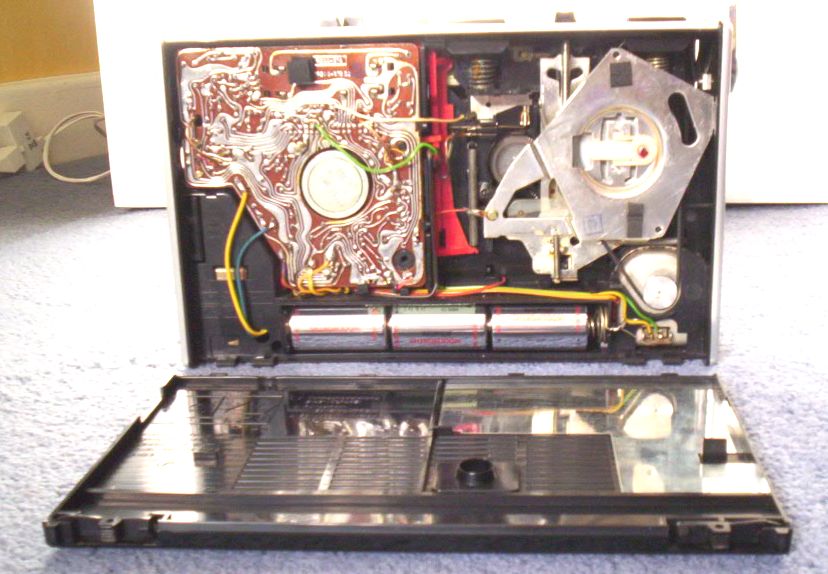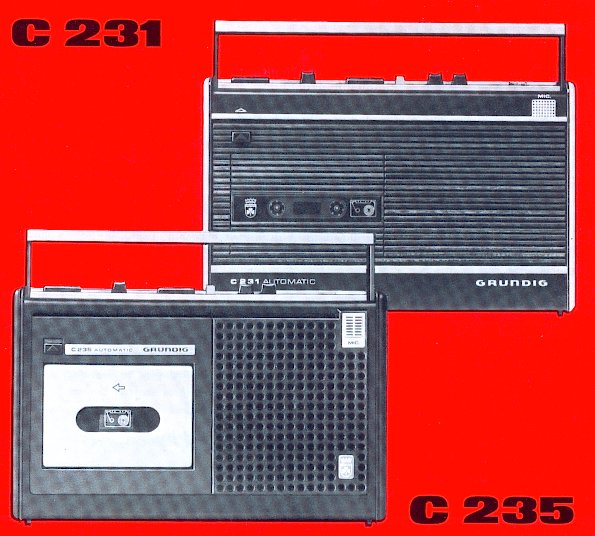 Radio
Boy
Radio
Boy
C260 cassette recorder -
1976 - 1978

 Rear view with back
cover removed, which is how you fit the batteries. Look at how neat and
tidy everything is, all the wiring is cleverly routed in ribbon style,
and there just isn't the "rats nest" so often found in cassette recorders.
Rear view with back
cover removed, which is how you fit the batteries. Look at how neat and
tidy everything is, all the wiring is cleverly routed in ribbon style,
and there just isn't the "rats nest" so often found in cassette recorders.
 C231/235 as shown
on instruction book cover, with slide away handle
C231/235 as shown
on instruction book cover, with slide away handle
Bought in December
2006 via Ebay. As I have stated on the "Grundig &
I" page, I had a C235, bought new in December 1975, but stolen in 1982.
(The person it was on loan to said it was stolen, anyway!) The C235 was
always a favourite of mine, and I'm glad I came across this set. If you
ever get the chance to own a Grundig portable cassette using this tape
transport, take it, it's one to treasure.
Sound quality and
build quality are both class leading, and it shows in the way this set
has survived. Grundig made several similar machines to this, the C235 as
I've said, also the C231, and several radio cassettes use the basic transport
from this machine, notably the C2001, C2500, C4100, C4200, c4500, C6000,
C6200 and there are probably many others that I've forgotten.
So, how to identify
the transport? Simple. There's a large push button marked "Start", then
a slider control for fast wind either way, then a button marked "Stop"
spaced the other side of the fast wind slider from the Start button, then
a red "Record" button. Various other versions add a pause control and tape
counter, but the layout of the controls mentioned remains unchanged.
The C260 is an updated
version of the C235, and has a detachable fold down "rally style" handle,
in place of the original slide away handle, which was superior in my opinion.
(Interestingly, if you remove the front of this machine, the fittings to
take the original slide away handle are still present). The C260 also omits
the battery meter of the previous models, an unnecessary cost cutting exercise
in my opinion. The meter was a small round one, and probably cost a few
pennies!
The most intriguing
thing about this machine, however, is that it does not state the country
of manufacture! The panel where it would be shown exists, but is blank.
Now, the C235 I had was marked "Made in United Kingdom" which in fact meant
Belfast, Northern Ireland. This factory opened in 1960, and it's closure
was officially announced on Monday, June 30th, 1980, so it would still
have been in operation when this machine was made. Some of the C230/231/235's
were made in Germany too, so this one could have been made in either factory,
I have to say, from memory, it certainly looks the same as the Northern
Ireland C235 I had!
In my opinion, this
model (by which I mean the C231, 235 & 260) is a design classic! You
only have to take a look inside one, see how everything is achieved with
the minimum of fuss and mess, all the basic elements are in self contained
groups (The motor housing for example, contains the motor AND the remote
control and speed control circuitry) giving a machine that is easy to service,
reliable, solidly built and capable of vastly superior performance to the
competition. Certainly, Grundig made machines which offered more, such
as stereo record/playback, chrome tape capability, and other extra facilities,
but all the basics are here, in a competitively priced package, with superior
performance. Take a look at the specs below, and compare them with the
figures for a Bush TP66, a fairly typical machine on the market at the
time, being a Japanese made, British badged model from the same era, which
I had owned previously.
Grundig C235
Bush TP66
Wow/flutter
0.25%
0.45%
Freq. response
80-10000 Hz
100-6000 Hz
Signal/Noise ratio
47 dB
40 dB
Output power
900mW
400mW
Speaker
130x70mm
87mm
Specs aren't always
"the whole story" but, believe me, I owned both back in the 1970's, and
own both now, and the difference in ability is remarkable.
Those of you who
have visited my site before will know I rate the Satellit 700 as a Grundig
design classic. I have to say, I would put this at number 2, as it achieves
everything it does with such high standards, and so little fuss.
Specification:
Styling:
Upright, plastic bodied,
black with silver trim. "Typical of the period" Grundig side
treatment of rectangular aluminium hoops, (Which was carried over from
the C231, the C235 had "all-black" side panels). Detachable "Rally Style"
handle. Slider Volume/tone balance controls, push button/slider tape controls.
Country of manufacture: United
Kingdom or Germany.
Size: 168 mm high x 260
mm wide x 62 mm deep.
Weight (excluding batteries):
1.9 kg.
Power supply:
Internal; 5 x C cells,
7.5V.
External; 120/240V AC
50-60 Hz
Consumption: 9 W
Battery meter: No. (But
present on C230/231/235 models)
Dial illumination:
Mono selection: N/A.
Sockets:
Inputs;
Din socket; Microphone,
(0.5 - 50 mV/16kohm)
Supply voltage for external
condenser microphone
Tape, record player,
(ceramic/crystal cartridge) (55mV - 5.5 V/2.2Mohm)
Outputs;
Din socket: amplifier,
tape deck. (>=400 mV/18kohm)
3.5mm earphone/speaker
socket.
Output power at 6 ohms: 1W
RMS (AC powered) or 0.9W RMS (battery powered)
Speaker: 130 x 70mm elliptical.
Tone control: Tone balance
(Bass/Treble.)
Clock/Timer: No
Tracks: 2, Mono.
Tape speed: 4.75 cm/s
Frequency response: 80
- 10000 Hz
Signal/Noise ratio: >
47 dB
Wow & flutter: <0.25%
Auto stop: No (Fast wind
selector non-locking, so manual release at end of tape.)
Recording level: Automatic.
Built-in condenser microphone.
Tape types:
Tape counter: No
Rewind time: Approx 55
seconds for a C60
1974
Catalogue entry (C231)




